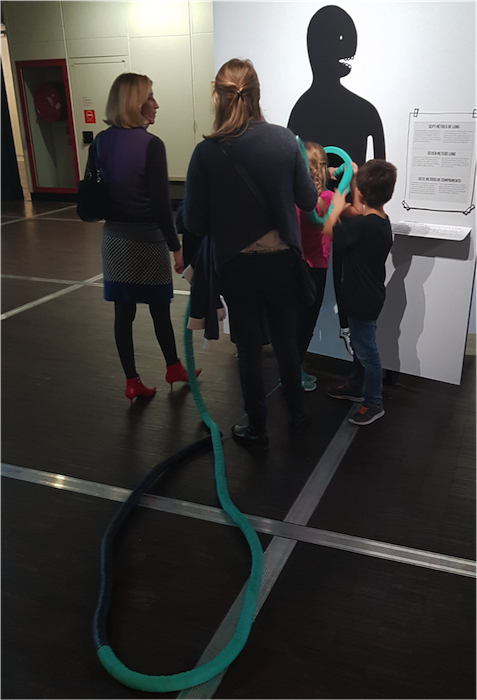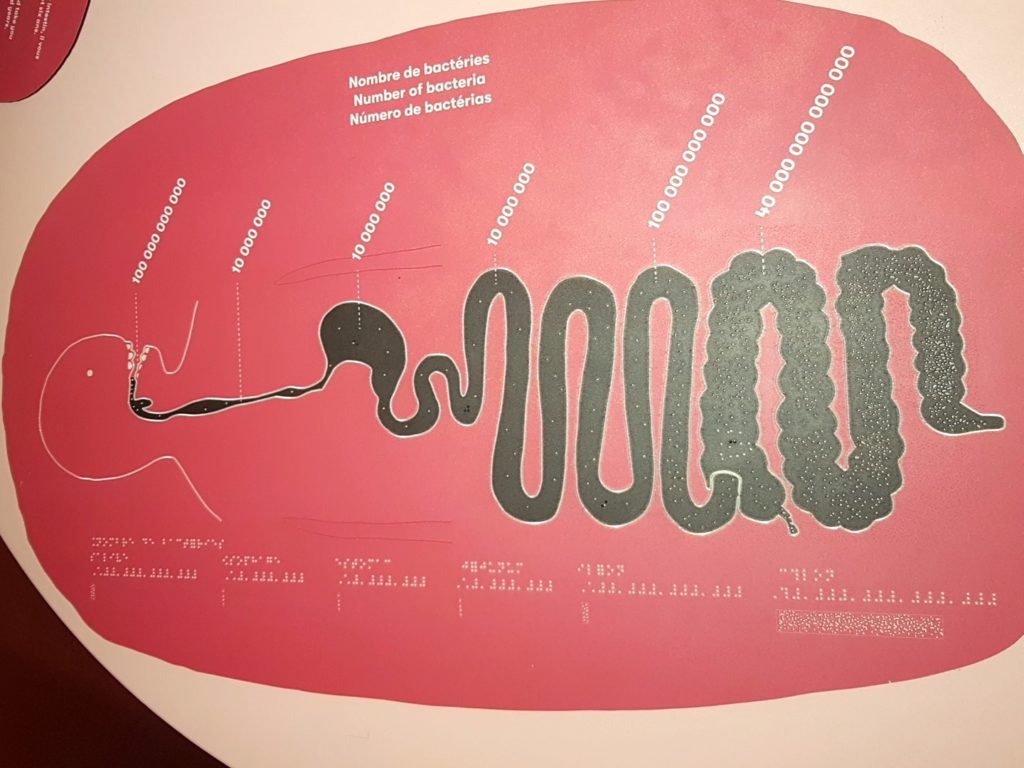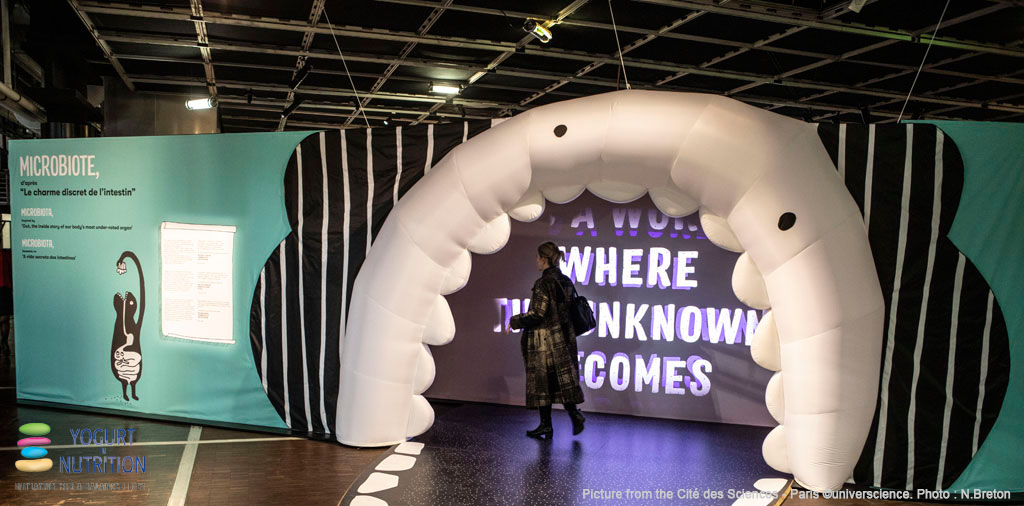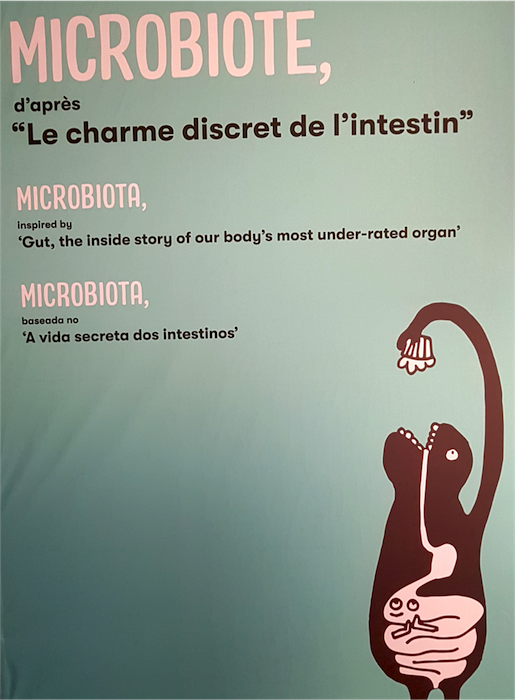Since the beginning of December 2018, the Cité des Sciences – the French museum for discovery and scientific culture – is hosting a comprehensive exhibition dedicated to the gut microbiota. We visited the exhibition and tell you in this article what we saw there. If you have the chance to be in Paris before August 4th 2019, we strongly advise you to go there !
A paedagogical approach to the gut microbiota
When entering the prestigious Cité des Sciences’ hall, visitors are welcome by a huge poster, which reads : MICROBIOTE. The exhibition is an adaptation of Giulia Enders’ best seller ‘Gut : The Inside Story of Our Body’s Most Underrated Organ’, and is an exploration of our microscopic inner life. So the show is built around different topics :
- human physiology of the intestinal tract (role of the gut, gut-brain axis, area covered by the gut…)
- stool samples and basic toilet education
- gut health (role of the gut microbiota, difference between lactose intolerance and cow’s milk allergy…)
- microbial diversity in the gut and their study (data about gut microbes, friends and foes, metagenomics…)
- how to favor a healthy gut with diet (prebiotics, probiotics, fermented foods benefits…)
Welcome to a world where the unknown becomes your own !

The visit starts with giant mouth, a gate to enter and discover the world within each and everyone of us. As of this moment, we step into the gut and discover a first room. A huge installation shows how the intestinal tract connects and exchanges information with our brain (for more information you can read our article about yogurt and the risk of depression, as well as possible benefits of fermentation).
All along the way, signs written in English, French and Spanish, give indications on what visitors see. At this stage of the visit, it highlights the idea that the gut microbiota constitutes an unknown organ of our body, which contributes to the healthy functioning of our organism.
The gut is huge and misunderstood !

Next, visitors enter what could easily be called the practical room ! The Bristol stool scale (or how to interpret your stool by its shape : kids laughing out loud !), an installation with a toilet showing how to best evacuate the bowels (also a kids’ major hit !), and a human model with a rope coming out of his belly to illustrate how long the gut is : a hands on and fun way to expose gut facts with humor and playfulness !
An interactive screen at the end of the room gives detailed information about common gut allergies to wheat, peanuts or milk. For the latter, the presentation makes a clear distinction between lactose intolerance and cow’s milk allergy, and explores the differences between the two phenomena (see our article on the subject). It reminds visitors that those who suffer from lactose intolerance are encouraged to keep on consuming dairy products such as yogurt and find for themselves the amounts they can easily tolerate (for more information on yogurt, lactose intolerance and maldigestion, read our dedicated questions and answers section).
Meeting our microbial friends
The third room of the exhibition is our first encounter with the gut microbiota per se. We learn that the gut is home to billions of exotic organisms : bacteria, yeasts, archaea, and viruses. Together this inner life forms what we call the gut microbiota, a huge variety of species and families. These tiny companions are very active and can impact our weight, our allergies, our immune system, as well as our behaviour and mood.

The paedagocial material starts by putting forward the key advances made by research in the past decade. Installations thus show the complexity awaiting researchers who seek to understand this lively envrionment : a lab with mice study, an anaerobic chamber, posters explaining basic principles of microbiology and more advanced explanations about techniques such as metagenomics.
The main challenge to analyze the gut microbiota is that most gut bacteria do not tolerate oxygen, which makes it impossible to study them under normal lab conditions. The recent technological advances in high throughput sequencing has made it possible to meet our microbial friends.
Let’s all take care of our gut microbiota
The exhibition ends with two interactive screens. The first enables visitors to hear the testimonies of microbes about their work inside us or their actions for our benefit such as fermentation. Visitors can thus listen to Lactobacillus delbrueckii subsp. bulgaricus & Streptococcus thermophiles explain how they produce yogurt (for more information on this topic, read our article “what is yogurt ?“).
A final interactive screen leaves the visitors with a few pieces of advice on how to take care of their gut microbiota. Firstly, feeding our microbiota with certain types of fibers, also called prebiotics, is a great way to help the good bacteria flourish. These are found in vegetables, whole grains, and starchy foods after they have been in the fridge. Secondly, the presentation explains that visitors can reinforce the diversity of the gut microbiota by regularly consuming live bacteria, which are beneficial for health, these are called probiotics. Mankind has been aware of these benefits : there are numerous examples worldwide of fermented foods like sauerkraut, kimchi, kefir, or yogurt (for more information about fermented foods, probiotics and fermentation benefits, read our article “which fermented foods contain the most ‘friendly’ bacteria“).
Understanding the gut microbiota, understanding our health
The “microbiote” exhibition at the Cité des Sciences is a great way to pass on facts about the gut microbiota, a topic, which has only recently come to the public’s attention. Visitors leave with a good grasp on what our microbial friends do for us and the ways to take care of them with healthy eating habits, such as including prebiotics and probiotics in our regular diet.
As the exhibition concludes, the most striking about the gut microbiota is that we come to realize that there are more bacterial cells than human cells in our body. So the more we understand about the gut microbiota, the more we will be able to understand our health.
Practical information
- “Microbiote” is an exhibition by the Cité des Sciences in Paris and will last until August 4h, 2019
- The complete visit takes two hours
- Giulia Enders’ best seller ‘Gut : The Inside Story of Our Body’s Most Underrated Organ‘
- Let us know what you thought about the exhibition on Twitter




